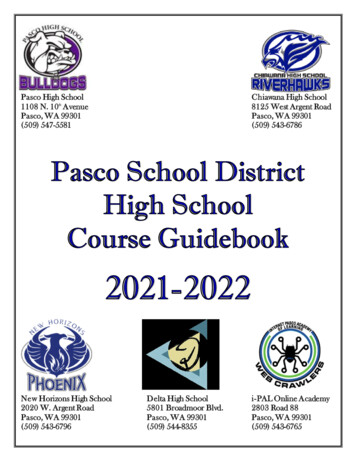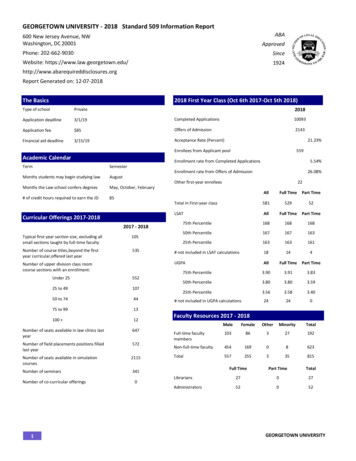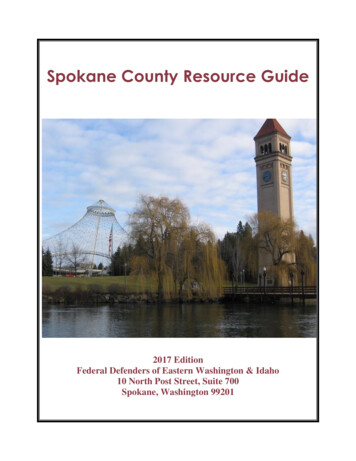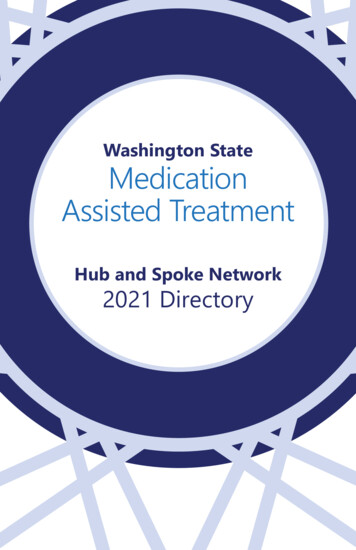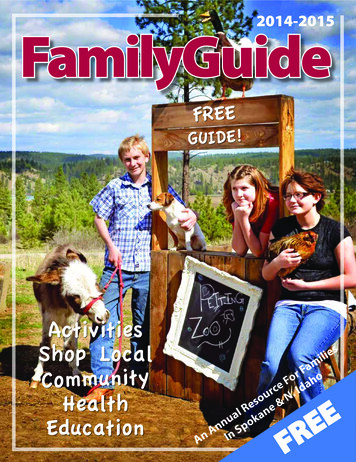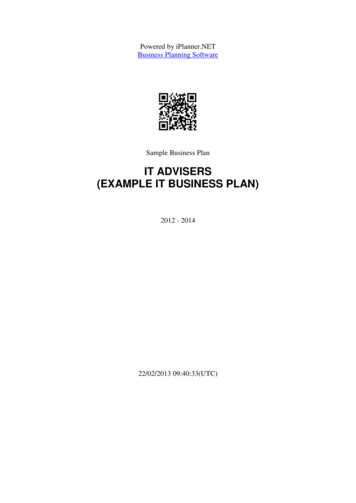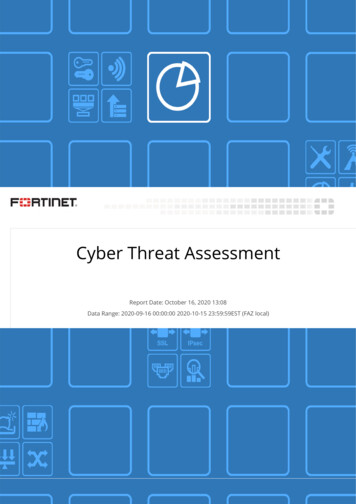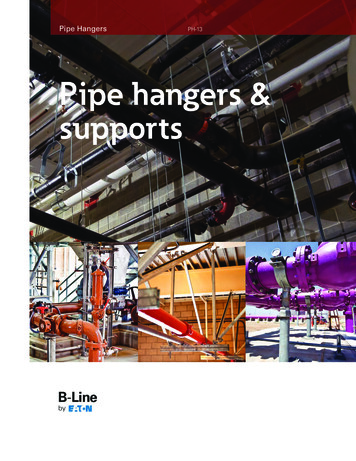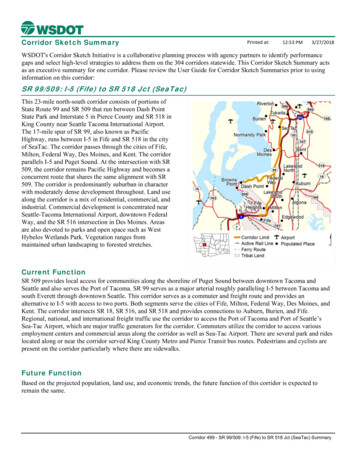
Transcription
Corridor Sketch SummaryPrinted at:12:53 PM3/27/2018WSDOT's Corridor Sketch Initiative is a collaborative planning process with agency partners to identify performancegaps and select high-level strategies to address them on the 304 corridors statewide. This Corridor Sketch Summary actsas an executive summary for one corridor. Please review the User Guide for Corridor Sketch Summaries prior to usinginformation on this corridor:SR 99/509: I-5 (Fife) to SR 518 Jct (SeaTac)This 23-mile north-south corridor consists of portions ofState Route 99 and SR 509 that run between Dash PointState Park and Interstate 5 in Pierce County and SR 518 inKing County near Seattle Tacoma International Airport.The 17-mile spur of SR 99, also known as PacificHighway, runs between I-5 in Fife and SR 518 in the cityof SeaTac. The corridor passes through the cities of Fife,Milton, Federal Way, Des Moines, and Kent. The corridorparallels I-5 and Puget Sound. At the intersection with SR509, the corridor remains Pacific Highway and becomes aconcurrent route that shares the same alignment with SR509. The corridor is predominantly suburban in characterwith moderately dense development throughout. Land usealong the corridor is a mix of residential, commercial, andindustrial. Commercial development is concentrated nearSeattle-Tacoma International Airport, downtown FederalWay, and the SR 516 intersection in Des Moines. Areasare also devoted to parks and open space such as WestHybelos Wetlands Park. Vegetation ranges frommaintained urban landscaping to forested stretches.Current FunctionSR 509 provides local access for communities along the shoreline of Puget Sound between downtown Tacoma andSeattle and also serves the Port of Tacoma. SR 99 serves as a major arterial roughly paralleling I-5 between Tacoma andsouth Everett through downtown Seattle. This corridor serves as a commuter and freight route and provides analternative to I-5 with access to two ports. Both segments serve the cities of Fife, Milton, Federal Way, Des Moines, andKent. The corridor intersects SR 18, SR 516, and SR 518 and provides connections to Auburn, Burien, and Fife.Regional, national, and international freight traffic use the corridor to access the Port of Tacoma and Port of Seattle’sSea-Tac Airport, which are major traffic generators for the corridor. Commuters utilize the corridor to access variousemployment centers and commercial areas along the corridor as well as Sea-Tac Airport. There are several park and rideslocated along or near the corridor served King County Metro and Pierce Transit bus routes. Pedestrians and cyclists arepresent on the corridor particularly where there are sidewalks.Future FunctionBased on the projected population, land use, and economic trends, the future function of this corridor is expected toremain the same.Corridor 499 - SR 99/509: I-5 (Fife) to SR 518 Jct (SeaTac) Summary
Highlights and PerformanceSouth of where the two highways converge in Federal Way, SR 99 is primarily a four-lane, undivided highway and SR509 is a two-lane, undivided highway. Both facilities have intermittent center turn lanes. Between Federal Way and SR518, the two highways converge and become a four-lane, divided highway with an HOV lane on each side. The annualaverage daily traffic is highest on SR 99 near Sea-Tac Airport and lowest on SR 509 near Dash Point State Park.What's working well?What needs to change? Roughly 98% of surveyed pavements on the corridorare in fair or better condition. King County Metro and Sound Transit provide fixedroute transit service on the corridor. There are no chronic environmental deficiencies orhabitat connectivity issues on the corridor. Projects identified in the 1999 Pacific HWY plan havebeen implemented, improving traffic flow and transit. Around 49% of the corridor experiences congestion ona regular basis. There are two bridge preservation needs on thecorridor. SR 509 has a high climate change vulnerability ratingand is susceptible to flooding events. Multiple fish passage barriers remain on the corridor.WSDOT monitors the state system in ongoing efforts to track asset performance. For this corridor, WSDOT finds:1) 2015 data unless otherwise noted. 2) For more information see the User Guide for Corridor Sketch Summaries at http://bit.ly/WSDOTcorridorsketchWhat we heard from our partnersWSDOT collected feedback from agency partners. Key themes include: Interest expressed in completing the I-5/SR 99 (54th Avenue E) interchange study. A desire for parking near a future Sound Transit light rail station in Fife. One partner has expressed interest in a new transit center and additional parking at Highline College.Corridor 499 - SR 99/509: I-5 (Fife) to SR 518 Jct (SeaTac) Summary
StrategiesWSDOT identified the following strategies and associated actions to keep the corridor working well and addressperformance gaps. Regional partners collaborated on high-level mobility strategies. The identified strategies are notmeant to be all-inclusive, nor an established list of priorities. Further evaluation is needed before any strategy can berecommended as a solution to address performance. Project funding decisions will take place at the programming phase,and are subject to statewide prioritization. For more strategy information, visit the Corridor Sketch Summary User Guide.Policy Goals / StrategiesEconomic VitalityUnder DevelopmentEnvironmentProtect and MaintainDescription and Near-Term ActionsWSDOT will continue to work with partners in developing strategies to addresseconomic vitality.Protect and maintain existing assets that provide environmental function (theseinclude WSDOT’s mitigation sites, storm water systems, fish passable culverts).Enhance or RestoreEnhance or restore natural areas and environmental functions associated with themultimodal transportation system.Fish Barrier RetrofitWSDOT has prioritized the removal of state-owned culverts that block habitat forsalmon and steelhead. See interactive map of uncorrected fish barriers Further information about the proposed strategies can be found attached at the endof this document.Based on expenditure history, it is expected that the top three activities will continueto be maintenance on snow and ice control, pavement repair, and sweeping andcleaning.PavementWSDOT has identified three Pavement actions in the next six years encompassing18% of the corridor.StructuresWSDOT has identified one Structures action in the next six years at a single locationon this corridor.SafetyInvestmentStewardshipPlanningWSDOT has identified one Safety Investment action in the next six years at a singlelocation on this corridor.Under Practical Solutions, the Corridor Sketch Initiative identifies corridorperformance, and assesses alternative strategies to improve the quality,effectiveness, and efficiency of the transportation system.Corridor 499 - SR 99/509: I-5 (Fife) to SR 518 Jct (SeaTac) Summary
Mobility assessment for segment of Corridor 499SR 99: I-5 to 54th Ave Vicinity (Milepost 0.00-0.28)This segment of SR 99 serves as an urban commuterand freight route alternative to I-5. This segment iswithin the city of Fife.This segment experiences five hours of congestiondaily.Corridor Segment Characteristics This segment of SR 99 is typically an urban fivelane facility (center two way left turn lane) withposted speeds of 30 mph in level terrain within theFife. The Freight and Goods Transportation designationwas T-1 between I-5 and 70th Ave E with18,340,000 in annual tonnage and 3,700 dailytrucks (15.8%) in 2017. The annual average daily traffic was 22,000 southof Porter Way (Old SR 514) in 2016.Contributing Factors High traffic volumes and signals at/near theI-5/SR 99 interchange reduce capacity. Emerald Queen Casino, Port of Tacoma, CostcoBusiness Center, nearby warehouses andautomotive dealerships generate traffic.Local Network Improvements Study implementing a Fife Frontage Road adjacentto a new SR 167 Puget Sound Gateway highwayto support anticipated warehouse district trafficdue to increased freight activity affecting trafficflow.Further Study Study the intersection of SR 99/Pacific Highway Eand 54th Ave E to consider adding a second leftturn in the short-term for the westbound directionto improve intersection performance. Using a practical solutions approach, revisit resultsfrom an interchange justification report for theI-5/SR 99 (54th Avenue E) interchange. The Cityof Fife feasibility study will identify long-termstrategies to improve efficiency. Study adding or widening existing sidewalks on54th Ave E to meet ADA standards and helppedestrian traffic. Complete the SR 167 Extension between Tacomaand Puyallup to manage congestion.Mobility Strategies:WSDOT compiled these strategies based on availableinformation and existing plans. The agency will workwith local partners to further develop strategies.Demand Management Consider adding a Park and Ride Lot to bemaintained by local transit authorities near a futuretransit station north of SR 99 (Pacific Highway E)to encourage mode shift. Consider flashing yellow arrows for efficiency.Corridor 499 - SR 99/509: I-5 (Fife) to SR 518 Jct (SeaTac) Summary
Mobility assessment for segment of Corridor 499SR 99: S 272nd Street to SR 518 (Milepost 12.9-20.4)This segment of SR 99 is a primary north-south routebetween Pierce County to the south and the SeattleTacoma International Airport to the north. It runs throughthe cities of Kent, Des Moines, SeaTac, andunincorporated King County. This segment serves localand regional through traffic and accommodatessignificant freight and commercial traffic.This segment experiences congestion.Corridor Segment Characteristics The average daily traffic on this segment ranged from27,000 to 36,000 vehicles in 2015. This segment was classified as a T-2 and T-3 freightroute with an average daily traffic ranging from 840 to1,700 trucks in 2015. The speed limit on this segment is 40 to 45 mph. This segment serves as an alternate route to I-5. This segment is located in a corridor with high levelsof existing development as well as considerabledevelopment potential. The adopted plan for this segment of SR 99 haslargely been built out.Contributing Factors Future expansion at the airport and the Port ofTacoma may worsen congestion. Lack of alternative north-south corridors causesadditional traffic on SR 99. Truck traffic during peak period contributes tocongestion. Existing levels of residential, commercial, and mixedland uses generate and attract traffic along thissegment.Operational Improvements Continue to implement corridor-wide accessmanagement improvements to improve trafficflow. Further implement transit priority measures tosupport Metro RapidRide service to increase modepublic transit use. Continue to include sidewalks and shoulders aspart of roadway expansions to increase traveloptions.Demand Management Reinforce support for existing Commute TripReduction programs at employer sites to reducesingle occupancy vehicle trips. Support the efforts of Sound Transit to extend lightrail service along the corridor to encourage modeshift.Further Study Develop options to reduce demand and facilitatetransit and ridesharing near Highline College. Update the 1999 Corridor Planning Study orprepare new studies to reevaluate the need forfuture improvements to SR 99 and the localnetwork to reduce congestion. Additional strategies to increase efficiency may beidentified in the Gateway/SR 509 extensionplanning process.Mobility Strategies:WSDOT compiled these strategies based on availableinformation and existing plans. The agency will workwith local partners to further develop strategies.Corridor 499 – SR 99/509:Tacoma to SR 518 Jct (SeaTac) Summary
For more informationTo find out more information about this corridor or how to get involved, please contact:Nazmul AlamCorridor Planning ManagerWSDOT Management of Mobility Division206-464-1267alamn@wsdot.wa.govWashington State Department of Transportation’s Corridor Sketch Initiative is a set of planning activities that engage our partners to define the context andperformance information for all of the state’s 304 highway corridors. The Corridor Sketch complements and supports regional planning processes in Washington. It isnot intended to duplicate, substitute or compete with other planning efforts; nor is it intended to generate lists of projects.Under 23 U.S. Code § 148 and 23 U.S. Code § 409, safety data, reports, surveys, schedules, lists compiled or collected for the purpose of identifying, evaluating, orplanning the safety enhancement of potential crash sites, hazardous roadway conditions, or railway-highway crossings are not subject to discovery or admitted intoevidence in a Federal or State court proceeding or considered for other purposes in any action for damages arising from any occurrence at a location mentioned oraddressed in such reports, surveys, schedules, lists, or data.Americans with Disabilities Act (ADA) InformationIndividuals requiring reasonable accommodations may request written materials in alternate formats, sign language interpreters, physical accessibilityaccommodations, or other reasonable accommodations by contacting the event sponsor (enter name of event sponsor and phone number), by (insert date-usually twoweeks advance notice). Persons who are deaf or hard of hearing may contact the event sponsor through the Washington Relay Service at 7-1-1.Title VI Statement to PublicIt is the Washington State Department of Transportation’s (WSDOT) policy to assure that no person shall, on the grounds of race, color, national origin and sex, asprovided by Title VI of the Civil Rights Act of 1964, be excluded from participation in, be denied the benefits of, or be otherwise discriminated against under any ofits federally funded programs and activities. Any person who believes his/her Title VI protection has been violated may file a complaint with WSDOT’s Office ofEqual Opportunity (OEO). For Title VI complaint forms and advice, please contact OEO’s Title VI Coordinator at (360) 705-7098.Información del Acta (ADA) de Estadounidense con DiscapacidadEste material se puede hacer disponible en un formato alternativo por correo electrónico al equipo de Asuntos de diversidad/ADA WSDOT enwsdotada@wsdot.wa.gov o llamando gratis, 855-362-4ADA (4232). Personas sordas o con problemas de audición pueden solicitar llamando el reléde estado de Washington al 711.Notificación de Titulo VI al PúblicoEs la póliza de el Departamento de Transportación del Estado de Washington de asegurar que ninguna persona sea excluida de participación o seanegado los beneficios, o sea discriminado bajo cualquiera de sus programas y actividades financiado con fondos federales sobre la base de raza,color, origen nacional o sexo, como proveído por el Título VI de el Acto de Derechos Civiles de 1964. Cualquier persona que cree que sus protecciones de Titulo VIhan sido violadas, puede hacer una queja con la Oficina de Igualdad de Oportunidades (OEO). Para información adicionalcon respecto a procedimientos de quejas de Titulo VI y/o información con respecto a nuestras obligaciones sin discriminación, por favor decomunicarse con le Coordinador de Titulo VI de la Oficina de Igualdad de Oportunidades (OEO) (360) 705-7082.Corridor 499 – SR 99/509:Tacoma to SR 518 Jct (SeaTac) Summary
This 23-mile north-south corridor consists of portions of State Route 99 and SR 509 that run between Dash Point State Park and Interstate 5 in Pierce County and SR 518 in King County near Seattle Tacoma International Airport. The 17-mile spur of SR 99, also known as Pacific Highway, runs between I-5 i

